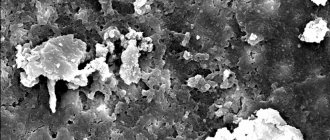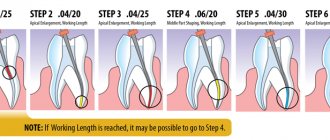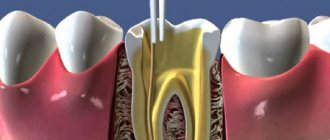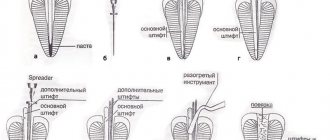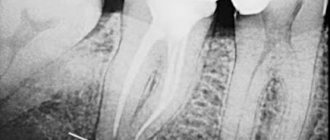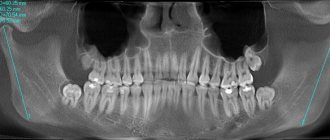General presentation and purpose
Profiles are instruments used for endodontic treatment. The full and official name is “Profile.04 Taper Series 29 Rotary Instruments”.
Initially, instrument sets were produced by the American company Tulsa Dental Product. Later, in tandem with the Maillefer company, the production of similar sets began in Sweden.
The difference lies in the optimization of products to ISO standards using European encodings and colors.
In dentistry, profiles are used for gradual expansion of root canals.
Working method
In the use of tools, the sequence is observed (10/.04 - 15/.05 - 20/.06 - 25/.06) of using threads with increasing taper. High-quality channel irrigation is ensured after treatment with a thin thread. The canal is cleaned to its full length using equipment that allows you to clean everything up to the mouth.
Mtwo instruments mark a new stage in optimizing root canal cleaning. The special properties of the material have improved their design and practical use.
Characteristics
Profiles are made of nickel (56%) and titanium (44%). Practice has shown that an alloy with the specified proportions gives flexibility to the product. This property is important in endodontic work, since the passages of the root canals are not straight, but curved.
The alloy is also known as nitinol, an erosion and corrosion resistant material. In addition to all its advantages, the alloy is also useful for its shape memory ability. The material is sensitive to sodium hypochloride - with constant contact, the instrument is destroyed.
According to the creators' concept, the profiles have a taper of 4% and 6%. The level is designated as 04 and 06. The given numbers mean an increase in diameter by 0.04 and 0.06 mm for each millimeter of the product, respectively. The diameter of each subsequent tool is 29% wider than the previous one.
A cross-section shows that the spiral is made with U-shaped grooves . The role of the grooves is to clean the hole made.
Thanks to the spiral structure, all cut fragments come out through grooves. On the outside, the spiral creates flat walls, which is necessary for a straight course of movement when drilling.
Another feature of the profiles is the presence of a non-aggressive top . When compared with the aggressive tip, the rounded tip of the instrument is noticeable - BAT Ttip. This structure reduces trauma and perforation of the apical region.
Hardening and heat hardening
To achieve the best properties of carbon and stainless steel, they are subjected to two types of heat treatments: hardening and hardening. Heat treatment gives the alloy hardness, but at the same time makes it brittle, especially with a high carbon content. Thermal hardening reduces stress in the metal and increases its strength. These properties are optimized by manufacturers. Heat of hand-held cutting tools during use can destroy the original properties of the alloys from which they are made and render the tools unusable. Firing over a flame or improper sterilization can easily render a good instrument unusable.
Kinds
The complex task of the profile is to pass the root canal with gradual expansion and cleaning of the passages.
Basic set
The main set of profiles is called Pro File Basic Seguency Kit. The kit consists of profiles with a 25mm working part. The components of the set have U-shaped grooves and non-aggressive tops.
The handles of machine and hand profiles have color rings that comply with ISO standards.
The kit includes a plastic handle that allows you to work the machine profile manually:
- estuarine – used to increase the width and depth of the root canal mouth and facilitate the passage of subsequent profiles;
- profiles with a taper of 0.6 are indicated by colors on the shank - yellow - 1 pc., d=0.20 mm; red – 1 pc., d= 0.25 mm; blue – 1 pc., d=0.30 mm.
- for profiles with a taper of 0.4, the shanks are painted accordingly - yellow with a diameter of 0.20 mm (1 pc.); red – with a diameter of 0.25 mm (1 pc.); blue – with a diameter of 0.30 mm (1 pc.).
- K-type manual dilators with a taper of 0.2 mm, made of nitinol.
The handle of the tools is comfortable to use. The handle and the working part are connected by spot welding. Under heavy loads on the profile, refraction will occur in this part. This type of instrument is used for initial movement along the root canal.
Features of dental restoration with Gradia Direct fillings and tactics of the procedure.
Come here if you are interested in how root canal obturation is performed with gutta-percha.
At this address https://www.vash-dentist.ru/lechenie/zubyi/plombyi/tsvetnyie-twinky-star.html we will tell you about the advantages of Twinky Star colored fillings.
Additional profiles
Profile Orifice Shaper is used to expand the mouth of the root canal. Thanks to the rounded tip, the passage into the canal has the shape of a wide funnel.
Profile OS are made of nitinol alloy and the product length is 19 mm.
Divided into:
- yellow – with diameter 06/20 (1 pc.);
- red – with diameter 06/40 (1 pc.);
- blue – with diameter 07/50 (1 pc.).
Intro Case Profile is intended for introductory procedures. The kit contains:
- Educational videos.
- Set of nickel-titanium profiles.
- Special endodontic tip.
- Training blocks for learning how to use the tool.
GT Rotary files
- Material – nitinol;
- Rotation – 200-350 rpm clockwise;
- A distinctive feature is that the taper of the working module is increased.
The GT Rotary Files set is presented in three sets:
The first set is the basic tools:
- has two-color markings on the shank;
- designed to perform manipulations using the Crown Down method;
- instruments have lengths of 21 and 25 mm;
- different taper from 6% to 12%;
- identical tip diameter equal to 0.20 mm;
- the set consists of 4 units.
The second set is apical instruments:
- the shank is painted with one color ring;
- used to treat the apical section of the root canal;
- The length of the apical instruments is determined by the ISO standard. It is 21; 25; 31 mm;
- taper of all units – 4%, or (.04);
- tip diameter varies from ISO No. 20 to No. 35;
- The set contains 4 tools.
Third set - wellhead tools:
- There are no color rings on the shank;
- The main task is to sharpen the mouth to the shape of the funnel;
- Same taper for all tools - 12%(.12);
- 35, 50, 70 mm – standard ISO sizes;
- The length varies in the range of 21-25 mm.
Pro Taper System
Designed for treating hard-to-reach areas of root canals. Difficulty in access is caused by either high calcification or excessive curvature of the root canal.
The kit includes 6 tools, divided into 2 groups:
- Shapers (shapers) – are able to change the shape of the channel to the required limit. Includes the following types - Sx (forms short channels), S1 (forms the upper third of the channels) and S2 (forms the middle third of the channels);
- Finishers (finishing formation of the apical part of the canal). Kit includes F1 (d=0.20, taper=.07%),F2 (d=0.25, taper=.08%),F3 (d=0.30, taper=.09%)
- Made of nickel and titanium alloy;
- In cross section, a convex triangular shape is determined;
- Increasing taper makes the tool as flexible and effective as possible in clearing the canal from cut out fragments.
СiТ Rotary Files
- Material – nickel-titanium alloy;
- Rotation speed is limited to 150-350 rpm;
- When working, it is important to use a lowering endodontic handpiece and a micromotor with a reduced speed level;
- The taper of the working area has been increased.
Flex Master System
The Flex Master endodontic system consists of:
- nickel-titanium Flex Master files;
- taper .02 (1 ring on handle), .04 (2 rings), .06 (3 rings);
- electric motor "VDW EndoStepper";
- system box;
- notepad for recording information about the operation of files.
The cross-section of the instruments is convex-triangular. This form is characterized by wear resistance, productivity during passage and a minimal level of curling.
When working, the Crown Down method is used. To determine the depth of the channel there are black notches located at a distance of 18, 19, 20, 22 mm from the cutting tip.
Purpose and packaging of Estelite filling material, instructions for use.
From this publication, find out what material is used for retrograde root canal filling.
Here https://www.vash-dentist.ru/lechenie/zubyi/plombyi/vozmozhnosti-materiala-filtek.html you will find fair reviews about the Filtek filling material.
KZ Endo
The K3 Endo system is distinguished by an asymmetrical triangular blade. This structure minimizes the possibility of decentralized entry into the channel , protects against breakdowns and increases the speed of operation.
The tip of the tool is non-cutting and non-aggressive. The presence of a short handle makes it easier to work with chewing teeth.
Mtwo endodontic instruments
Mtwo sets are produced by VDW (Munich, Germany)
The kit includes tools under different numbers:
- #25 – tip taper .06;
- #20 – tip taper .06;
- #15 – taper .05;
- #10 – taper .04
The kit also includes MtwoA for apex treatment and Mtwo R for re-treatment. The length of the tools is 21; 25 and 31 mm.
The cross section shows an S-shaped section with two cutting edges. The top of the instruments is non-aggressive. It does not cut, but only guides the tool.
Peculiarities
There are several features of Mtwo devices:
- negative main angle and positive front angle;
- specific helical angle for each file;
- identification color ring on the tail (determines size);
- The length of the threads varies from 21 (25) mm. up to 31 mm.
The advantages of these endodontic devices are a special alloy that gives them such properties, high cutting ability and a non-cutting tip. The helical angle provides mechanical stability and dynamic properties.
Standard tool operation
The use of profiles involves using a rotation speed in the range of 200-350 rpm.
The profile is inserted into ½ of the working part using the crown-down method. This helps to quickly reach the apical zone. It is preferable to work in the apical part using the “Step Back” technique.
For example, the use of Mallifer .04 profiles must meet the following requirements:
- Micromotor rotation speed – 150-350 rpm;
- The presence of reducing tips that stably retain the rotational power when the speed decreases.
Recommended sequence of endodontic actions:
- An x-ray must first be taken to examine the working length, the canal type, and the presence of apical foramina;
- Then profile 04. N25 (with the red mark) enters a third and then half the length of the channel at a rotation speed of 250 rpm
- The tool is replaced with 04. N30 (with a blue mark) and is also sequentially inserted to the previous depth.
- Next, profile N20 (with a yellow mark) is introduced into the channel , but only 3/4 of the channel length.
- Now comes the turn of operating with a manual K-file (N10-15). This is necessary to correctly determine the channel length. The correct method is to use an apex locator. If resistance occurs with light pressure, then repeat the manipulations described above.
- When the working length is reached, it is necessary to widen the canal with larger tool sizes (N20, then N25, etc.) until the canal size and final profile are equal.
If working with profiles has not yet become a habit, then to reduce the risk it is better to pass the last 2-3 mm remaining to the apical foramen manually, without the help of machine rotation.
Systematic irrigation of the canal with a 2.5% sodium hypochloride solution is recommended.
One profile is used in 6-8 channel operations. After this, it must be disposed of to avoid “metal fatigue”, leading to deformation or destruction of the tool.
Varieties and speed
Depending on the purpose of the devices, they are divided according to the diameter of the tip and taper, and the activity of the tip. There are two types in total:
- Mtwo A – used for the apical canal. They have three files – A1, A2, A3. Their diameter increases in ascending order, and so does their taper.
- Mtwo R – used for repeated canal treatment.
Models also differ in the length of the working part:
Mtwo tools are used at speeds of 250-350 rpm. Model R25/.05 should be used at 600 rpm to remove dentin chips from the ostial and mid-portion of the root canal during endodontic retreatment.
conclusions
The above information can be summarized as follows:
- machine profiles have high strength and wear resistance;
- safety is ensured due to the special shape, material and design of the cutting surface;
- clear markings that comply with standards increase the speed of work;
- The versatility of the instruments is due to the ability to penetrate and expand the canal while effectively removing dentinal filings.
If you find an error, please select a piece of text and press Ctrl+Enter.
Tags teeth filling
Did you like the article? stay tuned
Previous article
All the most important information about the purpose and use of the drug Kaustinerv in dentistry
Next article
Features and advantages of vertical condensation of gutta-percha
Purpose, characteristics
Advanced Mtwo system - fully rotating ProFiles, providing access to the apical canal through the dentinal layer with x-ray canal images. The following systems are distinguished:
- mtwo files;
- Mtwo tapers.
The devices are manufactured according to ISO quality standards. Their design allows access to hard-to-reach places. Their cutting surface is durable and is due to the shape of the files and tapers. Taper is a flexible device that, due to its spiral design and progressive pitch, allows passage into channel branches.
The production of such instruments is carried out by VDW, a company specializing in the production of medical devices for endodontics. The product manufacturing plant, located in Munich, is fully automated and all equipment is certified.
The price varies from 2084 to 2700 rubles. Main characteristics when choosing:
- working part length;
- taper;
- top diameter.
The instrument is packaged in blisters of 6 pieces, the packaging remains sterile during the expiration date.

